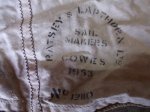Peacock$
New member
Hi,
As a first step into wooden boat ownership I picked up what I believe to be a Yachting World Dayboat on eBay. It came with a set of Patsey & Lapthorn sails dated 1953 which, if purchased new for the original boat, would put it as one of the first private builds.
It is a project which was abandoned some years ago and dry stored ever since. The hull appears to have had some attention and is well painted on the outside with several coats of Toplac which I am inclined to leave at this point. I am currently stripping the inside which is a mix of bare wood, varnish and very old peeling paint.
The question that I am currently considering is when and how to get it wet. Should I complete all the interior stripping and varnishing and then launch it - presumably at that point the planks will take up water and everything will move - or should I launch it now, or leave it outside a bit - so that the hull can take up some moisture - and then varnish it while touch dry.
I have been using Epifanes clear gloss on the floorboards which seems to go on nicely.
I would welcome any comments from those more experienced than I - i.e. everyone.
Many thanks
Graham
Suffolk
As a first step into wooden boat ownership I picked up what I believe to be a Yachting World Dayboat on eBay. It came with a set of Patsey & Lapthorn sails dated 1953 which, if purchased new for the original boat, would put it as one of the first private builds.
It is a project which was abandoned some years ago and dry stored ever since. The hull appears to have had some attention and is well painted on the outside with several coats of Toplac which I am inclined to leave at this point. I am currently stripping the inside which is a mix of bare wood, varnish and very old peeling paint.
The question that I am currently considering is when and how to get it wet. Should I complete all the interior stripping and varnishing and then launch it - presumably at that point the planks will take up water and everything will move - or should I launch it now, or leave it outside a bit - so that the hull can take up some moisture - and then varnish it while touch dry.
I have been using Epifanes clear gloss on the floorboards which seems to go on nicely.
I would welcome any comments from those more experienced than I - i.e. everyone.
Many thanks
Graham
Suffolk







